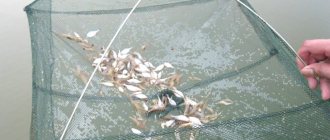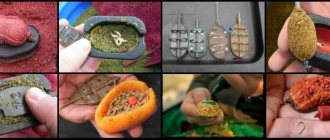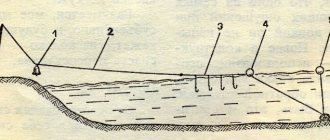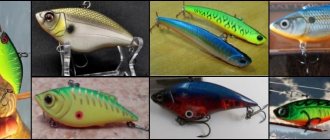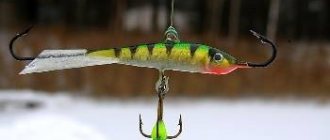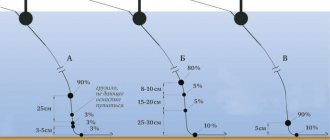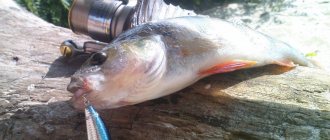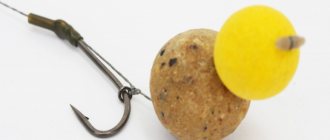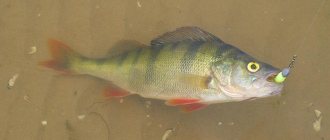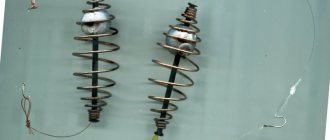Personally, I catch crayfish in a variety of ways and am very much looking forward to the end of the ban on catching them. I can say that crayfish on our table is not a delicacy, but a familiar dish, and practically free at any time of the year, even in winter and autumn. I make the shells myself, with my own hands, and I take the drawings from books, the Internet, some left over from my grandfather.
The success of my fishing largely depends on the fact that I know where to catch crayfish in a river or lake, in what places to place crayfish traps and what baits are needed. There is nothing particularly complicated, and after reading this article, you will learn a lot of new things and can successfully fish anywhere on your own. The main thing is not to break the law, which I consider quite fair, since it contributes to an increase in the population of these crustaceans, which are unfortunately rare in our area.
How to catch
Nowadays, crayfish is a much rarer catch than fish. Crayfish meat is tender and tasty, and more and more beer lovers prefer it as a snack. In addition, crayfish is often used as bait when fishing for large predatory fish.
Crayfish with beer
A large crayfish can reach a length including claws of twenty centimeters or even more! The weight of large individuals is up to 200 grams - 5 crayfish is already a kilogram! Catching such specimens in our time is real luck; catching one is a great success! Usually you come across crustaceans a little more than ten centimeters in size, even in those places where crayfish are found in abundance. We will describe in more detail how to catch crayfish using a crayfish trap in order, starting with their manufacture.
Catching crayfish with a merezh
The most common model of hedging is domed with a round bottom. Such a hem has a rod for tying bait and a “collar” made of plastic, birch bark or tin. The diameter of the hoop at the bottom of the hem is approximately 40 cm, the diameter of the neck is 15 cm, and the height is 15-30 cm.
The frame for a standing hem, essentially one of the types of crayfish, is made as follows. The lower hoop is connected to the neck hoop with pieces of wire in 4-6 places.
In the dome frame, the rods that connect the hoops are curved inward. Other forms of hemlines have straight or slightly curved rods.
A round, necessarily slippery (so that the caught crayfish cannot escape), “collar” with a diameter of 10 cm, which can be made of tin, plastic or birch bark, is glued to the inside of the neck.
Many crayfishers make the neck removable: after removing it, the crayfish pour out of the mesh with ease. The upper part of the neck can be made of mesh, and the “collar” can be moved to the lower tackle.
| Advice. Make the diameter of the hem collar slightly smaller than the diameter of the neck. |
To extract crayfish from the mesh, it is turned upside down, and its “collar” comes out, resulting in the formation of a funnel through which the caught crayfish fall.
Folding hems
Folding hems are very convenient. They are easy to store and transport to the place where you will catch crayfish.
They are installed vertically, with the neck attached to the upper bow. Folding hems do not have supporting frame rods.
The neck of the hem is made of mesh, and a wire ring is attached to the bottom edge. When the hemline is lifted from the reservoir, the ring is pulled out and the neck straightens.
For folding hems, you can use removable “collars”.
Figure 5. Merezhi
1 - conical; 2 - dome; 3 - semi-cylindrical; 4 - triangular; 5 - folding; 6 - wooden; 7 - easy to install; 8 - improved model.
In order to attach the bait to the standing fences, a twig with bait attached is passed across the fence. The twig is attached to the mesh with a split end. Hang the bait on a hook or on a piece of fishing line right in the middle of the line. The bait either hangs, tied to a fishing line (the fishing line is stretched across the neck), or lies fixed at the bottom of the net.
| On a note. But it is best if the bait hangs, because the crayfish, being in the trap, should not completely destroy the bait. In this case, the bait must be attached in such a way that the crayfish cannot pull it out entirely. |
A twig with bait can also be attached to the neck in its lower part.
The crayfish are taken out of the mesh through the neck, and the mesh is turned upside down. You can also get crayfish through a special opening valve.
Recumbent hems are lowered to the bottom in a horizontal position. Such hemlines have 1 or 2 necks and an oblong shape. The neck of the mesh is located parallel to the bottom of the reservoir. Recumbent hems can be cylindrical, semi-cylindrical and triangular.
Cylindrical hems
Cylindrical hems are used mainly in reservoirs with crayfish, where the bottom is rocky and uneven. They are placed vertically.
Such hemlines are made from rods. New models of cylindrical hems are made of mesh.
At the ends of the hemline there are necks, the diameter of which is about 10 cm. In order for the hemline to be straightened, its necks are connected to each other with 3-4 laces.
And here's what you need to know: Catching fish with a line - FISHING
The laces usually run straight or crosswise through the hem. The laces also create an additional obstacle for those crayfish that, having already been caught, are trying to get out.
The length of the hem is half a meter, diameter is 20 cm.
The neck of the cylindrical hem is a narrow slit. The gap is formed by the laces that are attached to the hoops (the laces are tightened). Crayfish easily fall into the trap, and the crayfish can no longer get out of it through the narrow mesh gap.
| On a note. The most catchy ones are considered to be those made from wooden planks and rods, i.e. wooden. The effectiveness of such barriers is determined by the fact that they are darkened: crayfish even during the day seek shelter. |
Triangular hems
This is another productive way to hunt crayfish. This device is similar in design to a crayfish trap, but significantly improved. The main feature of the fence is the ability to let prey inside and not let it out. The object of fishing easily falls into the trap, but it does not manage to get out.
Depending on the location of the neck, traps are:
- standing, where the neck is at the top of the device;
- recumbent, the neck can be located not only on one, but also on both sides.
The use of hems significantly simplifies the process of catching crayfish; they free the fisherman from constant control over them.
How and when is crayfish fishing allowed?
Everyone knows that properly cooked crayfish is exceptionally tasty, especially with beer, and therefore the question of when it is allowed to catch crayfish and whether it is possible to catch crayfish at all worries not only crayfish fishermen, but also ordinary people. But it is worth knowing that there are regions in which crayfish fishing is prohibited at all, regardless of the time of year, such regions include Moscow and the Moscow region. Those who violate this law may be prosecuted. So before you go catching them, find out whether it is possible to fish for them in your region and in what months, i.e. When can you catch crayfish? On my own behalf, I can give advice that since these representatives of the order of crustaceans are very rare, refrain from catching them at a time when the females are carrying eggs, and if you accidentally catch such an individual, release it. Much is not known, but crayfish mate in winter and at this time their eggs appear.
You also need to know that there are restrictions on their catching and size. It is allowed to catch crayfish nine to ten centimeters long. The measurement is carried out as follows. The body itself is measured from the eye line to the tip of the tail. It is allowed to use no more than 3 shells per person. The diameter of each tackle is more than 0.8 m, the cell pitch should be less than 2.2 millimeters. Probably many people don’t know, but catching crayfish by wading or diving is also not allowed. You will be fined for such an act.
Ban on catching crayfish
Prohibitions on catching crayfish in the regions are established by the Fishing Rules for each fishing basin!
- Astrakhan region - a ban on catching crayfish is established from April 1 to June 30. At the time when crayfish can be caught, their size must be at least 10 cm.
- Bryansk region - the ban on catching crayfish is valid from October 1 to June 30.
- The Vladimir region has established a ban on catching crayfish from October 1 to June 30.
- Volgograd region - the ban on catching crayfish is established from January 1 to September 14, and in the Tsimlyansk Reservoir the ban on catching freshwater crayfish is valid from January 1 to September 15.
- The Vologda region prohibits catching crayfish during the period of gestation, as well as during molting and from June 15 to July 31. During the period when crayfish can be caught, their size must be at least 9 cm.
- Kaliningrad region - the ban on catching crayfish is valid from October 1 to June 30.
- The Kirov region has established a ban on catching crayfish from October 1 to June 30, and in the Yug River with its tributaries it is prohibited to catch crayfish from June 15 to July 31.
- Ban on catching crayfish in the Krasnodar Territory: For the Black Sea and the basins of rivers flowing into it, the ban on catching crayfish is valid from January 1 to May 31.
- For water bodies of fishery importance in the Azov Sea basin: from January 1 to June 14.
- from June 5 to July 15 - crayfish in water bodies of fishery importance in the Svetlinsky and Yasensky districts; from June 15 to August 10 - crayfish in other water bodies of fishery importance in the region.
- from January 1 to June 10 - freshwater crayfish in water bodies of the Manych River basin;
Fishing with a crayfish
Open type of shells
Raklovki, or otherwise crayfish or racheshni, are quite convenient and catchy fishing gear. They are inexpensive, and if necessary, you can make them yourself. These gears may have different designs. For the simplest one you will need some mesh, wire and wood. The easiest to make is the so-called crayfish - a grip very similar in appearance to a plate. It can be made from wire or a regular wooden circle. If the crayfish is round, then its optimal dimensions are from fifty to seventy centimeters. You need to stretch the net over this circle so that it can sag in the center.
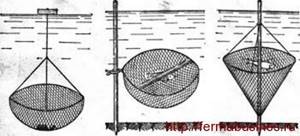
Open type shells
If you need a crayfish trap for deep fishing, then you need to tie 3 or 4 ropes to it and connect them with a knot to which a rope is tied, with the help of which the tackle will rise and fall. A float is attached to the end of foam or other material. This gear is suitable and crayfish can also be caught in it in winter.
For fishing in the shallows, another tackle is better suited; its difference from the one described above is that the float needs to be replaced with a pole, which will need to be stuck into the ground during fishing. The bait must be tied to a pole or directly to the center of the net.
A rack has a similar design, which consists of a circle (wire or wooden), a cone-shaped bag in it with a sinker fixed in the center. Typically, such tackle is baited with ordinary worms (preferably dung), they are strung on a thin wire and attached to a circle. This type of clamshell is lowered and raised using a rope.
Catching crayfish using crayfish traps is a very easy task, but you need to know that if you lift such gear slowly or it tilts, the crayfish will have time to scatter. Therefore, it rises quickly and sharply. It is better to fish with crayfish from a boat. Just immerse it in the place where the crayfish may be. Gear is checked approximately every twenty minutes. This crayfish catcher can be used almost the whole year, and even catching crayfish in the fall using this gear will be successful. The only thing is that the bait for crayfish should be different, and we will tell you which one later.
Closed shells
Closed crayfish traps are very catchy and are sometimes called night or crayfish houses. Fishing with them is much more convenient, but they are more difficult to manufacture than open ones. They are often made so that they can be folded. The main advantage of such crayfish traps is that they do not need to be constantly checked. You need to remove them and check them no more than two or three times during the night, or you can even leave them until dawn.
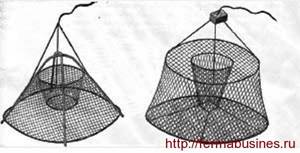
The simplest closed shells
There are many designs of night crayfish traps. The simplest ones are made from a wire frame (the sizes may vary, but we recommend the following: the diameter of the lower circle is forty to fifty centimeters, the upper circle is twenty-five to thirty-five centimeters, the height is 15 centimeters). You need to stretch the net over the frame so that there remains a hole with a diameter of about six centimeters. Sometimes closed racks are made higher, up to twenty-five centimeters; at the entrance, depending on the design, one or more necks are made of wood. The entrance hole must have a diameter of at least five centimeters. They are secured with guy ropes to the bottom circle. Tackle with several necks is more catchy. And if you have chosen this one, then you should know that it is better to place them obliquely. This will significantly increase catchability.
Fishing rules
A place for catching crustaceans should be chosen near a steep slope. It will be good if there are a lot of shelters at the bottom where crayfish can live. In addition, crustaceans often live in burrows under massive stones.
It should be remembered that very polluted reservoirs with a sandy bottom are not suitable for hunting crayfish. In this case, nothing depends on the depth. If all the necessary conditions are present at the bottom of a river or lake, then crayfish can live both in the shallows and in the depths.
It is most effective to catch arthropods at night. Therefore, many fishermen set closed traps until the morning , after which they check it. You can also get a pretty good catch in cloudy weather.
The shell needs to be placed directly from the shore. If numerous traps will be installed, it is better to use a boat. In order not to lose the device, you need to attach a piece of foam plastic to it on a rope.
Video “Crayfish climb into the crayfish trap”
This video shows how crayfish, sensing bait, climb into an open crayfish trap.
Approximately the same principle applies to crayfish traps of a slightly different type, which are called butchi or gobies, which are crayfish traps with two necks. Their shape can be arbitrary; both square and cylindrical are allowed. The maximum length is 70 centimeters, diameter up to twenty centimeters. They are made from pine splinters. Secure to six circles with wire. There are 2 necks at the ends. The diameter of the inlet is from five to seven centimeters. A door is made at the top, which is necessary for pulling out caught crayfish and laying bait with a stick.

Butches and bulls
The main disadvantage of closed-type crayfish traps, in addition to the complexity of their manufacture, is their rather large size. Fishing with such gear is carried out on one specific body of water. Crayfish fishers who fish in various bodies of water prefer folding or dismountable crayfish.
A folding night light is made from a pair of wire circles (the diameter of the lower one is about 33 centimeters, the diameter of the upper one is about seventeen centimeters), the inlet hole is located in the neck, the diameter is about 6 centimeters. In this design, an additional float is attached, which keeps the tackle deployed. You need to put a sinker, a metal object or some kind of stone inside. This crayfish trap, like all others, is raised with the help of a rope, at the end of which a float is tied.
Collapsible vent
This gear is designed approximately like a butch. It is made up of 3 wire circles (diameter from 20 to 25 centimeters). A net is pulled over the mugs, and two necks (length 27 centimeters, entrance about six centimeters), attached to each other with ropes. A pair of wire spacers, split at the ends, rest against the outer circles and keep them taut. Along with similar ones, gear with several necks is also used; crayfish go into this type of crayfish trap more readily.

Rachevnya with several necks
Rachevnya (rakolovka)
The most popular means for catching crayfish is crayfish. The rachevnya is a cylindrical mesh that is stretched over a metal round hoop. Hoops are made from wire treated with galvanic coating. The diameter of the hoop is half a meter. 3-4 thin cords are tied to the hoop.
Figure 4. Rachevnya
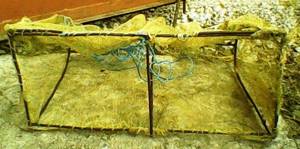
a - with one hoop; b - with two.
To avoid skewing, the cords should be tied at the same distance between them. The cords are connected by a common knot, into the loop of which a strong cord is inserted so that the gear can be lowered and raised.
The cord is attached to a long stick. The bait is tied to a net, to a stretched cord (according to the diameter of the hoop).
The cord can be replaced with a stick, which is also attached to the hoop. The trap sinks to the bottom.
You can catch crayfish using crayfish traps by placing several of them at a distance of 4-9 meters from each other. At the first sign of a crayfish entering the trap, the crayfish immediately rises.
Catching crayfish with a crayfish will become more effective if you use a crayfish with two hoops. With this option, the crayfish, lying on the bottom, folds, and when pulled out, the mesh stretched between the hoops does not allow the crayfish to crawl out of the trap.
The diameter of the crustacean is about half a meter. These hoops are made from wire treated with a special galvanic coating.
In the old days, they were made from flexible willow branches, after first placing a stone or a piece of iron in the center of the rachen - so that the mesh was pulled downwards. Several laces of equal length are tied to a circle of wire.
This is necessary so that the tackle does not become warped. The laces are connected with a knot, and a rope is threaded into it for lowering and raising the rachenov.
You can fish from the shore or from a boat - in this case, the rope is attached to a pole.
It is important to know how to properly attach bait and what to use to catch crayfish in crayfish traps. The bait is tied to a net or to a cord stretched over a hoop.
The principle of fishing with a crayfish trap is based on the fact that a crayfish caught in it is not able to get out, since the tackle immediately rises. This must be done immediately.
And here's what you need to know: Catching carp with a spinning crocodile video
There is no need to limit yourself to one camp - you can arrange several. It is advisable to leave the distance between them about 5–10 meters.
Crayfish will be attracted by the smell of meat or fish - these products can be used as bait.
To catch crayfish, open and closed type crayfish traps are used. The maximum effect is obtained from the use of closed type traps.
Basic recommendations when catching arthropods with crayfish:
- Among the large assortment of traps, cylindrical-shaped crayfish are the most catchy; square variations cause difficulties during operation (cling to stones, uneven bottom);
- the size of the trap in this case is of great importance, the optimal option is no more than 90 cm in any direction;
- The bait for the crayfish must be fixed on a special hook.
What's the best way to store crayfish?
In the summer, the caught crayfish are placed in a cage, the hole of which must be tied up and kept in running water while you are fishing. If you catch crayfish at night, then you can keep them not in water, but on land, just in a basket.
In the case of long-term fishing, you need to know that crayfish quickly die in direct sunlight, as a result of which they need to be kept in a shaded place.
Crayfish stay only in water in winter because frost is destructive for them.
Some of the best gear for catching crayfish are night crayfish, which do not require constant monitoring and make it possible to simultaneously engage in crayfish fishing along with fishing.
This video shows successful fishing with crayfish
Where to catch crayfish
The answer to the question of where to catch crayfish is simple - crayfish are found exclusively in clean water bodies . If the water in a reservoir is heavily polluted or not rich enough in oxygen, then catching crayfish in it is a futile exercise. Therefore, it is better to catch crayfish in rivers than in lakes, where the water stagnates faster. Crayfish live at different depths: in some reservoirs you can catch crayfish by going into the water just above the knee, while in others you will have to catch crayfish at a depth of 2 - 3 m. Crayfish are lovers of rocky bottoms, in which they can find many hiding places. You can also catch crayfish in reservoirs with a clay bottom, in which crayfish dig holes for themselves under steep shady banks, the length of the holes is at least a meter. But where it is not worth catching crayfish is in shallow places with a hard sandy bottom; crayfish do not tolerate reservoirs with a muddy bottom densely covered with algae.
Catching crayfish with a fishing rod
After we have discussed how to catch crayfish using crayfish traps, let’s look at the next piece of gear, a crayfish fishing rod. To catch crayfish with a fishing rod, you need to make a special tackle; it is very easy to make. You need to take a wooden stick, sharpen one end and, after attaching the bait, stick it into the ground. The bait is wrapped in fine mesh or fabric; even an ordinary women's nylon stocking may be suitable. Having found the bait, the crayfish will grab it with its claws, and at this moment it must be pulled out. As a rule, the crayfish holds onto its prey well, but you still need to pull it out of the water very carefully. If you pull sharply, the crayfish will simply fall off the bait.

One of the options for catching crayfish with a fishing rod
For convenience, a fairly long piece of fishing line or twine is often tied to the bait, with a float attached to the end of it. If the bait does not sink, then you need to hang additional weight. The rod is periodically removed from the water to check the presence of prey and the condition of the bait.
What bait to catch crayfish with
Opinions often differ on the best crayfish bait, so it's worth reading the tips and using them to your own discretion. Or maybe, by experimenting, you will discover your own unique bait for crayfish and you yourself will give recommendations on which bait is best for catching crayfish:
- Tip 1. It is best to use fresh fish as bait for crayfish, not rotten fish, as many people believe. Experienced crayfish fishermen also add a little dill with the bait and, in a mesh bag, a piece of cake and a slice of rye bread, the crust of which has been rubbed with garlic.
- Tip 2. Fish, meat, frogs or grasshoppers are also suitable as bait for crayfish. Moreover, the more spoiled and smelly the bait, the better, since crayfish feed on carrion. The smell that attracts crayfish will be stronger if the carcass is cut along the back to the vertebrae and the meat is turned outward.
Making a clamshell with your own hands
Catching crayfish is not difficult. It is enough to have even one crayfish trap, which is easy to make with your own hands. The lightest and most frequently used crayfish catcher is a ring with a diameter of about 45 centimeters made of wire, which is covered with mesh. The disadvantage of this system is the need to check every half hour, since the crayfish, having eaten the bait, can simply run away.
We suggest you make a more convenient crayfish trap, once in which the crayfish will no longer be able to get out of it.
We will need
- fine mesh mesh;
- a piece of wire with a diameter of about five millimeters;
- plastic clamps;
- nylon thread.
Manufacturing:
First we need to make a couple of metal rings. The diameter of the lower one is about 45 centimeters, the diameter of the upper one is about 17 centimeters.
We attach the mesh to the ring using plastic clamps approximately every 6 centimeters. If you cannot find plastic clamps, then nylon thread may also be suitable for fastening.
We make three spacers from thinner wire; electrodes with a diameter of 3 millimeters are well suited for these purposes. The spacers must be made the same length and so that the ring with a smaller diameter is in the center at approximately a height of 15 centimeters.
If you want to make a folding shell, then make one of the 3 spacers removable. The remaining 2 are attached to rings.
Once the spacers are in place, tighten the sides of the frame. Next, you need to grab them using clamps to the upper ring.
We fix the clamps on the upper ring every 12 millimeters. We cut off the extra pieces and our soup is ready! Now you can go to a pond and try it out by installing it in a place where crayfish can be found. Do not forget that the bait must be tied.
Rachevnya from a plastic bottle
This gear is considered the simplest of its kind. But despite the simplicity of execution, it can please you with a good catch.
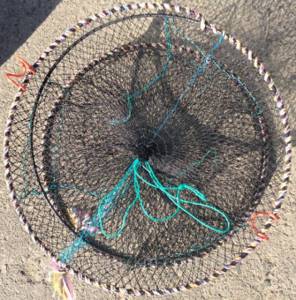
To make a crayfish shell with your own hands from a plastic bottle, we will need:
- 5 liter plastic bottle
- Scissors
- Fishing line or wire
- Awl
- Nail
- Rope
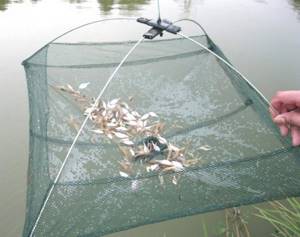
So, let's start assembling the shell.
- First of all, take the bottle and cut off the top part of it (along with the neck). This is approximately 5-7 cm from the beginning of the neck.
- Turn the top part over and insert the neck into the inside of the bottle. Thus, the cancer will crawl into the bottles and fall into the middle, and to get out it will have to try really hard.
- We need to connect these halves together using fishing line or wire. We make holes for connections with an awl.
- Now you need to make holes in the bottle itself for better air release. To do this, heat the nail and start making holes.
- At the bottom we attach a weight and a hook for bait. It is more convenient to do this by removing the top part of the shell and then fastening it again.
- In the place where the two halves join, we tie a rope or thick fishing line, 3-5 m long.
Read here Balda for perch - gear and tips on how to catch perch correctly. 115 photos and videos of perch fishing

Already near the reservoir, we attach the bait to the hook, hold the trap by the rope and throw it directly into the water. On the shore we tie the cord to a peg or tree. We are waiting for the catch.
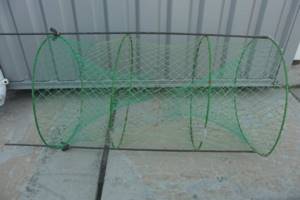
Distribution of bait by season
Bait for catching crayfish in spring
In the spring, fish meat is better suited for catching crayfish, in particular the sirloin or small fish, cut so that the meat emits a smell. Of all the breeds, crucian carp and bulls are best suited.
Bait for catching crayfish in the summer
Summer is the best time to catch crayfish, but you need to know that in the summer season, when water bodies abound with various foods, the best bait is meat. Crayfish have an excellent sense of smell and willingly go for the entrails, namely the liver, stomach, as well as the ears or cheeks of animals, which are very cheap at any market.
Bait for crayfish in autumn and winter
In autumn and winter, when it has become colder, the amount of food in reservoirs decreases and it becomes more difficult for animals to obtain it, so catching crayfish in October or even November can be more successful than even in the warm season. Many will be surprised, but at this time the best bait is bread with garlic. You need to do the following. Take a piece of rye bread and press unpeeled garlic cloves into it, which must be wrapped in gauze or other thin cloth. Otherwise, the bread will simply become soggy and the crayfish that are in the crayfish can simply pull it apart. It is equally permissible to use meat and fish, but preferably stale ones. The fish used for bait should have a smell that attracts crayfish. To do this, the carcass is cut and the scales are peeled off a little. Catching crayfish in the fall is also more profitable because at this time the price of crayfish is slightly higher than in the summer. Crayfish are especially expensive in winter.
What seasons are the best for catching crayfish?
Cancer is very sensitive to changes in weather conditions, as well as to water temperature. And that’s why it is caught differently at different times of the year. Fishing times:
- January and February are very cold times of the year and cancer practically does not leave its shelter. So fishing is reduced to a minimum or absent altogether.
- In March and April it is caught, but very poorly. Since he is just starting to get out of his holes after the big cold.
- In May and June, the crayfish begins molting and is caught, but not well enough yet. But immediately after molting, he begins to eat.
- July and August are good for fishing as they gain fat before spawning.
- But September and October are considered the most favorable and trophy fishing periods. The shells do their job perfectly. Before winter he gets hungry again. Caviar begins to appear.
- November, December are good times for fishing. The crayfish becomes fatty, and the females gradually accumulate eggs.
- In the period from October to May - caviar crayfish.
We recommend reading: Equipment for feeder fishing on currents

